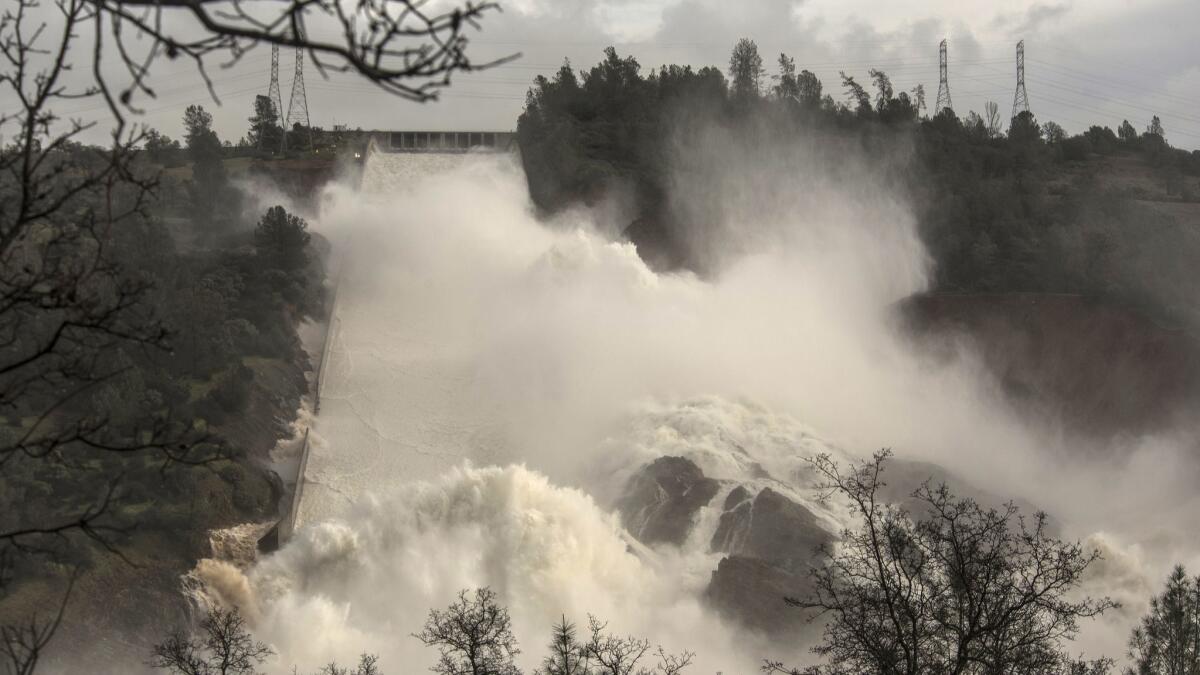Climate change will make California’s drought-flood cycle more volatile, study finds

- Share via
Californians should expect more dramatic swings between dry and wet years as the climate warms, according to a new study that found it likely that the state will be hit by devastating, widespread flooding in coming decades.
UC researchers in essence found that California’s highly volatile climate will become even more volatile as human-caused climate change tinkers with atmospheric patterns over the eastern Pacific Ocean.
The long-term average of annual precipitation in California won’t change much, they predicted.
“Yet despite that, we see a big increase in extremes,” said UCLA climate scientist Daniel Swain, lead author of a paper published Monday in the journal Nature Climate Change. “We expect to see more really wet years and also more really dry years.”
The recent past offers a glimpse of California’s future.
The state veered from years of record-breaking drought that emptied reservoirs and prompted unprecedented urban conservation to a parade of atmospheric rivers that dumped record precipitation on Northern California during the 2016-2017 rainy season.
Portions of the main spillway at Lake Oroville, the state’s second largest reservoir, collapsed and the state narrowly escaped a dam disaster that would have sent a wall of water roaring through downstream towns.
Such sudden swings between severe drought and intense storms will increase the threat to aging dams and flood-control networks, accentuate the wildfire threat and make management of the state’s complex waterworks even more daunting.
The key ingredient of last year’s deadly wildfires in the wine country and the huge Thomas fire, which set the stage for devastating debris flows in Montecito, was high winds, not the drought-flood seesaw that researchers describe. But the scientists do predict the kind of dry autumn that contributed to the intensity of the Thomas fire, which burned its way into the record books in December.
“We really need to be thinking seriously about what we’re going to do about these risks,” Swain said.
“It’s a little bit hard to exaggerate how disastrous a repeat of the 1862 flood would be in California,” he added, referring to statewide flooding that followed weeks of storms.
That is “something that will very plausibly happen in the next 40 years,” sending floodwater rushing across the Los Angeles basin and other major urban areas, he said.
The study results, based on climate model simulations, are consistent with other research findings, said Daniel Cayan, a climate researcher at Scripps Institution of Oceanography who was not involved in the study.
“I think they’ve pushed the envelope forward in elucidating how the extremes on the wet and dry side have increased,” he added. “The thing that I think is really nice about this paper is that they identify … a period in which there could be a really profound wet spell. That’s very important.”
By the end of the century, California will experience a 100%-200% increase in very wet years similar to the 2016-2017 rainy season that broke the state’s five year drought, the scientists found.
The frequency of serial storms on the scale of 1862 will increase 300%-400%.
At the same time, the rainy season will shorten as less precipitation falls in the autumn and spring.
That will make it harder for dam managers, who on the one hand will have a shorter season to capture water for storage, and on the other will need to maintain reservoir space for greater storm runoff.
“Increasingly wide swings between dry and wet conditions will threaten to upset the already precarious balance between competing flood-control and water-storage imperatives in California,” the researchers wrote.
In Southern California, the frequency of extremely dry years is expected to rise 200%, compared with a 150% increase in very wet seasons. Overall, the region’s average annual precipitation should remain the same.
In addition to accentuating the whiplash between dry and wet, global warming is shrinking the state snowpack, which acts as nature’s reservoir.
“Climate change is creating a water-storage problem for California,” said UCLA atmospheric sciences professor Alex Hall, a co-author of the paper.
“We need to think more carefully about how we capture water and how we store it,” he added, advocating greater efforts to recharge groundwater basins with storm flows.
“That’s certainly where I would start,” he said.
Twitter: @boxall
UPDATES:
5:35 p.m.: This article was updated to include context about the Thomas fire.
2 p.m.: This article was updated to include more context about the 2016-2017 rainy season.
This article was originally published at 8 a.m.
More to Read
Sign up for Essential California
The most important California stories and recommendations in your inbox every morning.
You may occasionally receive promotional content from the Los Angeles Times.










